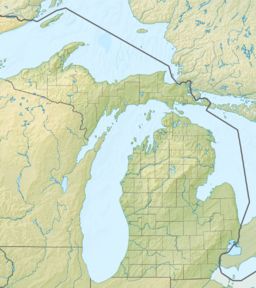| Lake Maumee | |
|---|---|
 Stages of great lake development. | |
| Location | North America |
| Group | Great Lakes |
| Coordinates | 41°48′48″N 82°27′55″W / 41.8133°N 82.4652°W |
| Lake type | former lake |
| Etymology | Wabash River Sixmile Creek Channel, 780 ft (238 m) Imlay Outlet, 849 ft (259 m) |
| Primary inflows | Laurentide Ice Sheet |
| Primary outflows | Wabash River |
| Basin countries | Canada United States |
| First flooded | before 17,500 years before present |
| Max. length | 326 mi (525 km) |
| Max. width | 113 mi (182 km) |
| Residence time | 1300 years in existence |
| Surface elevation | 800 ft (244 m)[1] |
| References | The Pleistocene of Indiana and Michigan, History of the Great Lakes; Chapter XIII, Glacial Lake Maumee; Frank B. Taylor; Monographs of the United States Geological Survey, Vol LIII; Frank Leverett and Frank B. Taylor; Washington, D.C,; Government Printing Office; 1915 |
Lake Maumee was a proglacial lake and an ancestor of present-day Lake Erie. It formed about 17,500 calendar years, or 14,000 Radiocarbon Years Before Present (RCYBP) as the Huron-Erie Lobe of the Laurentide Ice Sheet retreated at the end of the Wisconsin glaciation. As water levels continued to rise the lake evolved into Lake Arkona and then Lake Whittlesey.
- ^ The Pleistocene of Indiana and Michigan, History of the Great Lakes; Chapter XIII, Glacial Lake Maumee; Frank B. Taylor; Monographs of the United States Geological Survey, Vol LIII; Frank Leverett and Frank B. Taylor; Washington, D.C,; Government Printing Office; 1915
